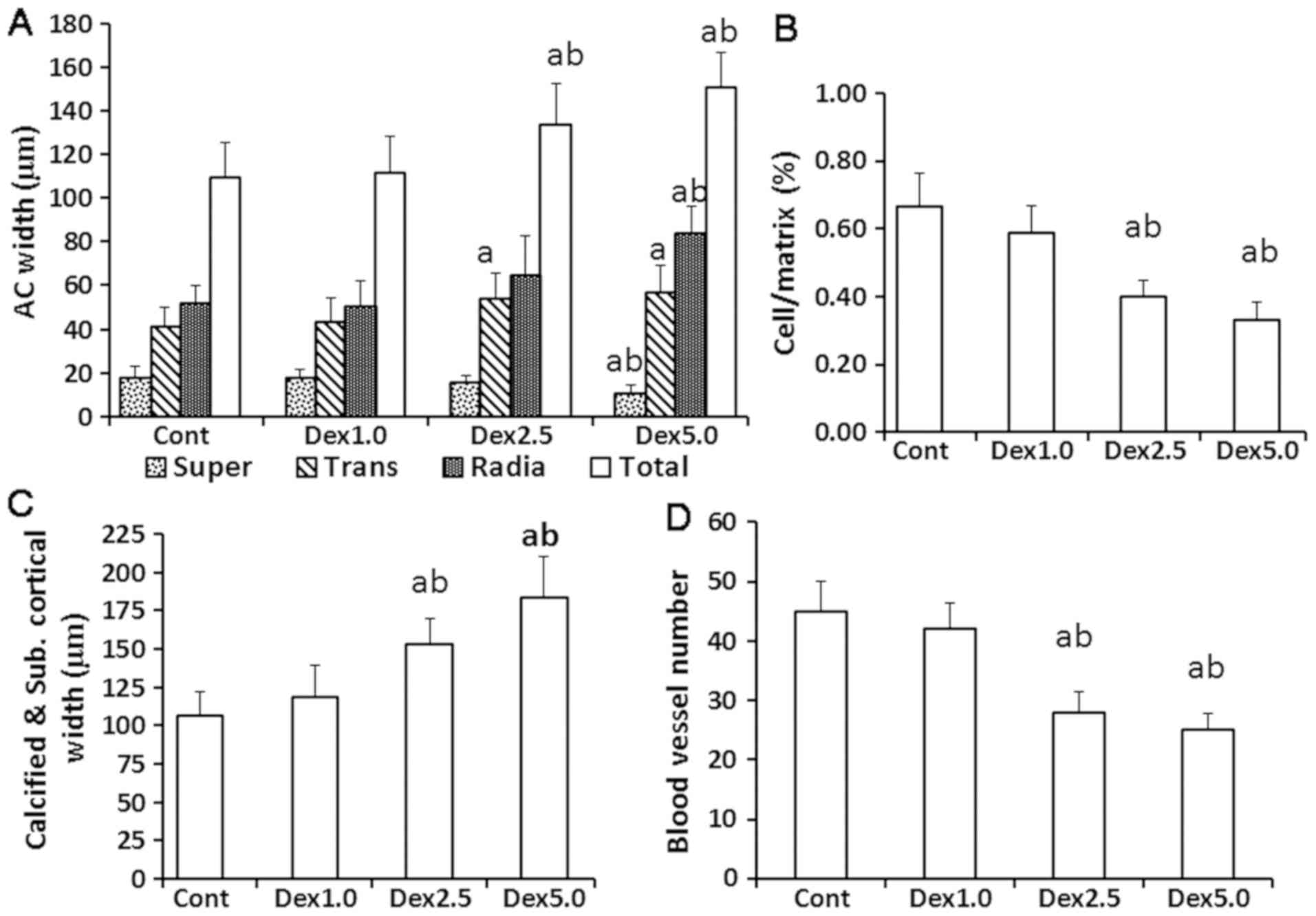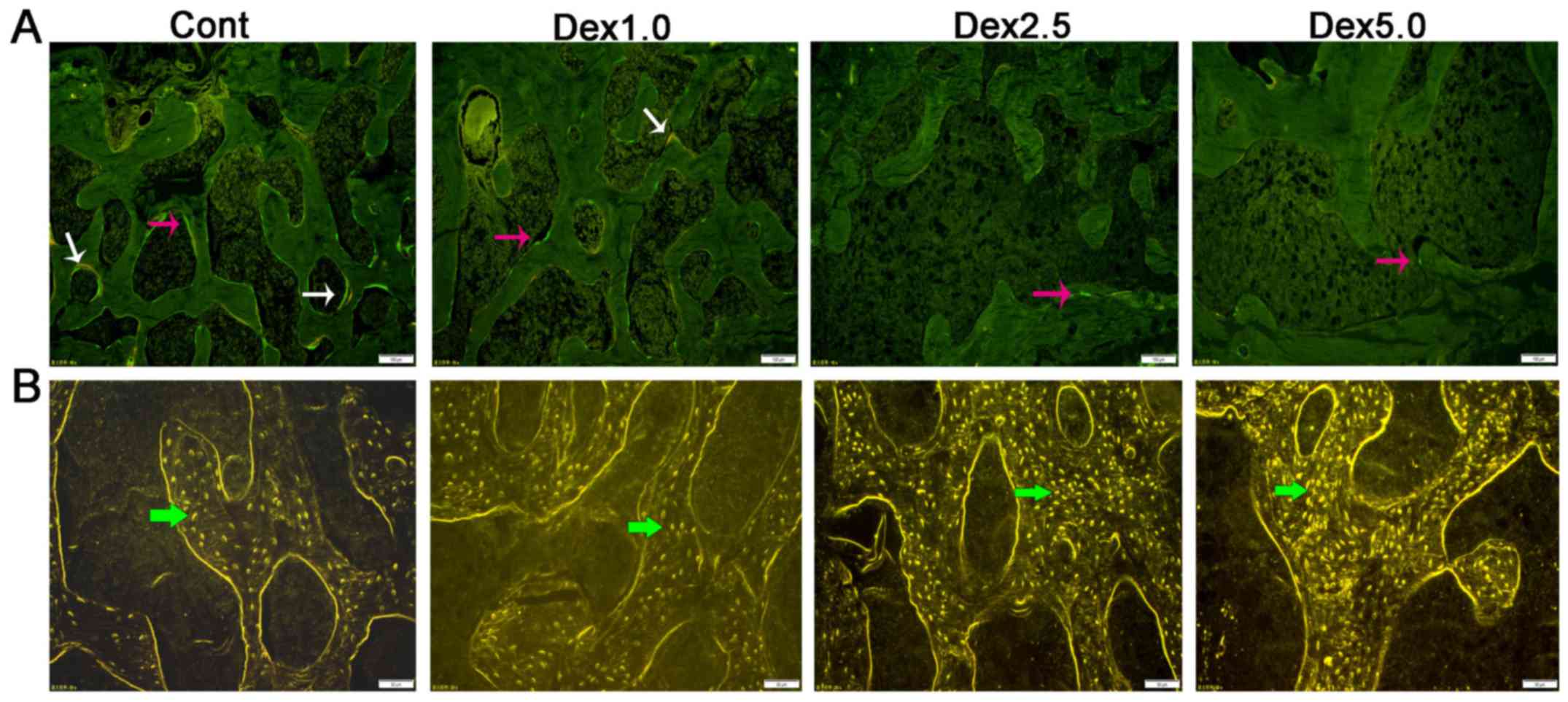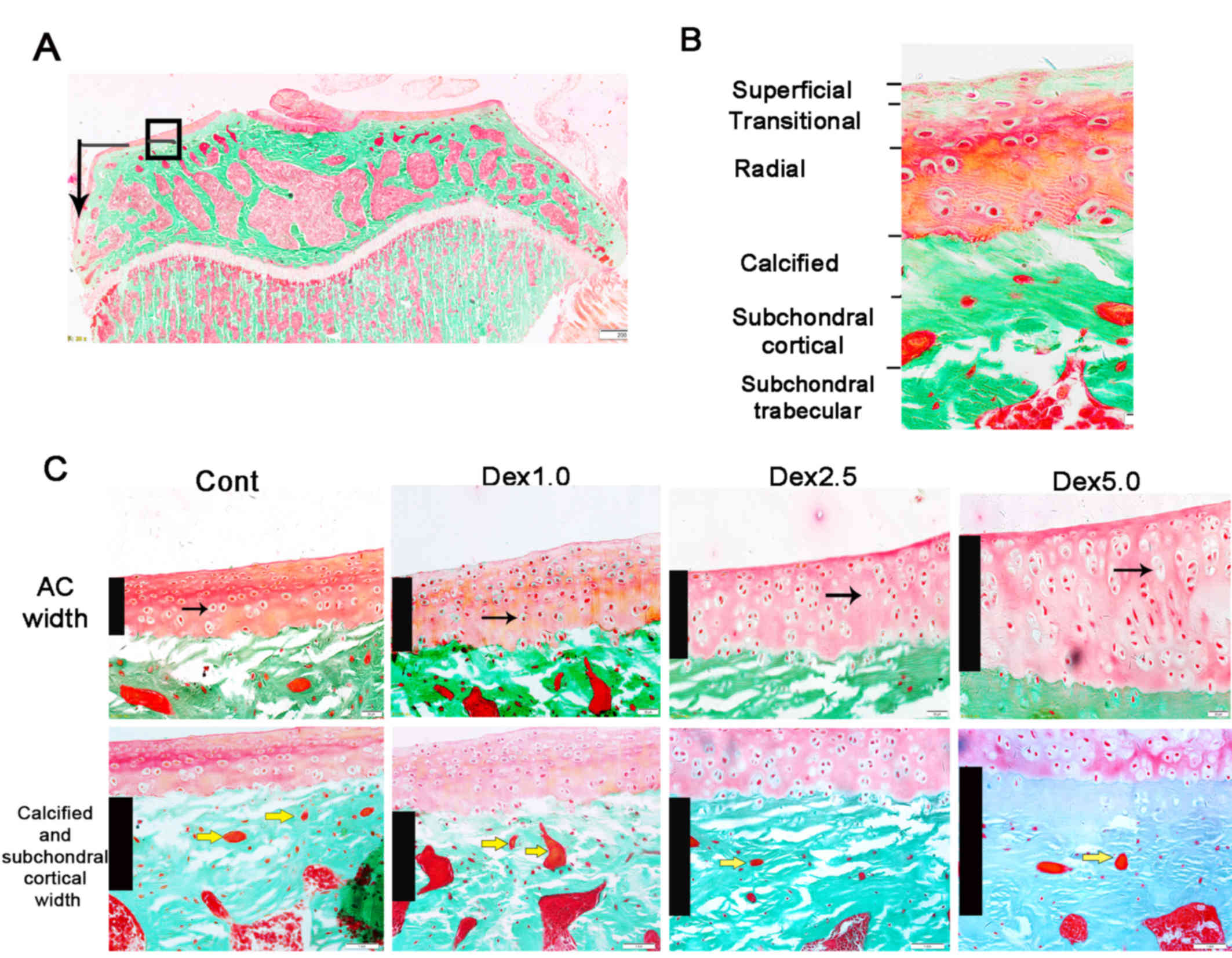|
1
|
Whittier X and Saag KG:
Glucocorticoid-induced osteoporosis. Rheum Dis Clin North Am.
42177–189. (x)2016. View Article : Google Scholar : PubMed/NCBI
|
|
2
|
Cao H, Guan H, Lai Y, Qin L and Wang X:
Review of various treatment options and potential therapies for
osteonecrosis of the femoral head. J Orthop Translat. 4:57–70.
2015. View Article : Google Scholar : PubMed/NCBI
|
|
3
|
Gong LL, Fang LH, Wang HY, Peng JH, Si K,
Zhu J, Han FF, Wang YH, Du GH, Pei LX and Liu LH: Genetic risk
factors for glucocorticoid-induced osteonecrosis: A meta-analysis.
Steroids. 78:401–408. 2013. View Article : Google Scholar : PubMed/NCBI
|
|
4
|
Xie XH, Wang XL, Yang HL, Zhao DW and Qin
L: Steroid-associated osteonecrosis: Epidemiology, pathophysiology,
animal model, prevention, and potential treatments (an overview). J
Orthop Translat. 3:58–70. 2015. View Article : Google Scholar : PubMed/NCBI
|
|
5
|
Weinstein RS: Glucocorticoid-induced
osteonecrosis. Endocrine. 41:183–190. 2012. View Article : Google Scholar : PubMed/NCBI
|
|
6
|
Liu R, Liu Q, Wang K, Dang X and Zhang F:
Comparative analysis of gene expression profiles in normal hip
human cartilage and cartilage from patients with necrosis of the
femoral head. Arthritis Res Ther. 18:982016. View Article : Google Scholar : PubMed/NCBI
|
|
7
|
Weinstein RS, Hogan EA, Borrelli MJ,
Liachenko S, O'Brien CA and Manolagas SC: The pathophysiological
sequence of glucocorticoid-induced osteonecrosis of the femoral
head in male mice. Endocrinology. 158:3817–3831. 2017. View Article : Google Scholar : PubMed/NCBI
|
|
8
|
Dong YL, Zhou L, Li YL, Xiao K and Weng
XS: Establishment and assessment of rat models of
glucocorticoid-induced osteonecrosis. Zhongguo Yi Xue Ke Xue Yuan
Xue Bao. 37:152–156. 2015.PubMed/NCBI
|
|
9
|
Wang D, Miller SC, Liu XM, Anderson B,
Wang XS and Goldring SR: Novel dexamethasone-HPMA copolymer
conjugate and its potential application in treatment of rheumatoid
arthritis. Arthritis Res Ther. 9:R22007. View Article : Google Scholar : PubMed/NCBI
|
|
10
|
Rentsch C, Schneiders W, Manthey S,
Rentsch B and Rammelt S: Comprehensive histological evaluation of
bone implants. Biomatter 4. pii. e279932014.
|
|
11
|
Dempster DW, Compston JE, Drezner MK,
Glorieux FH, Kanis JA, Malluche H, Meunier PJ, Ott SM, Recker RR
and Parfitt AM: Standardized nomenclature, symbols, and units for
bone histomorphometry: A 2012 update of the report of the ASBMR
histomorphometry nomenclature committee. J Bone Miner Res. 28:2–17.
2013. View Article : Google Scholar : PubMed/NCBI
|
|
12
|
Moghadam-Kia S and Werth VP: Prevention
and treatment of systemic glucocorticoid side effects. Int J
Dermatol. 49:239–248. 2010. View Article : Google Scholar : PubMed/NCBI
|
|
13
|
Tu J, Stoner S, Fromm PD, Wang T, Chen D,
Tuckermann J, Cooper MS, Seibel MJ and Zhou H: Endogenous
glucocorticoid signaling in chondrocytes attenuates joint
inflammation and damage. FASEB J. 32:478–487. 2018. View Article : Google Scholar : PubMed/NCBI
|
|
14
|
Gu Y, Zhou J, Wang Q, Fan W and Yin G:
Ginsenoside Rg1 promotes osteogenic differentiation of rBMSCs and
healing of rat tibial fractures through regulation of GR-dependent
BMP-2/SMAD signaling. Sci Rep. 6:252822016. View Article : Google Scholar : PubMed/NCBI
|
|
15
|
Goetzen M, Hofmann-Fliri L, Arens D,
Zeiter S, Stadelmann V, Nehrbass D, Richards RG and Blauth M: Does
metaphyseal cement augmentation in fracture management influence
the adjacent subchondral bone and joint cartilage?: An in vivo
study in sheep stifle joints. Medicine (Baltimore). 94:e4142015.
View Article : Google Scholar : PubMed/NCBI
|
|
16
|
Neumann AJ, Gardner OF, Williams R, Alini
M, Archer CW and Stoddart MJ: Human articular cartilage progenitor
cells are responsive to mechanical stimulation and
adenoviral-mediated overexpression of bone-morphogenetic protein 2.
PLoS One. 10:e01362292015. View Article : Google Scholar : PubMed/NCBI
|
|
17
|
Grogan SP, Duffy SF, Pauli C, Koziol JA,
Su AI, D'Lima DD and Lotz MK: Zone-specific gene expression
patterns in articular cartilage. Arthritis Rheum. 65:418–428. 2013.
View Article : Google Scholar : PubMed/NCBI
|
|
18
|
Findlay DM and Kuliwaba JS: Bone-cartilage
crosstalk: A conversation for understanding osteoarthritis. Bone
Res. 4:160282016. View Article : Google Scholar : PubMed/NCBI
|
|
19
|
Liu N, Wang W, Zhao Z, Zhang T and Song Y:
Autophagy in human articular chondrocytes is cytoprotective
following glucocorticoid stimulation. Mol Med Rep. 9:2166–2172.
2014. View Article : Google Scholar : PubMed/NCBI
|
|
20
|
Tomaszewska E, Dobrowolski P and Puzio I:
Morphological changes of the cartilage and bone in newborn piglets
evoked by experimentally induced glucocorticoid excess during
pregnancy. J Anim Physiol Anim Nutr (Berl). 97:785–796. 2013.
View Article : Google Scholar : PubMed/NCBI
|
|
21
|
Grogan SP, Duffy SF, Pauli C, Koziol JA,
Su AI, D'Lima DD and Lotz MK: Zone-specific gene expression
patterns in articular cartilage. Arthritis Rheum. 65:418–428. 2013.
View Article : Google Scholar : PubMed/NCBI
|
|
22
|
Zhang M, Shi CY, Zhou ZL and Hou JF: Bone
characteristics, histopathology, and chondrocyte apoptosis in
femoral head necrosis induced by glucocorticoid in broilers. Poult
Sci. 96:1609–1614. 2017. View Article : Google Scholar : PubMed/NCBI
|
|
23
|
Madsen SH, Andreassen KV, Christensen ST,
Karsdal MA, Sverdrup FM, Bay-Jensen AC and Henriksen K:
Glucocorticoids exert context-dependent effects on cells of the
joint in vitro. Steroids. 76:1474–1482. 2011. View Article : Google Scholar : PubMed/NCBI
|
|
24
|
Zhang YL, Yin JH, Ding H, Zhang W, Zhang
CQ and Gao YS: Vitamin K2 prevents glucocorticoid-induced
osteonecrosis of the femoral head in rats. Int J Biol Sci.
12:347–358. 2016. View Article : Google Scholar : PubMed/NCBI
|
|
25
|
Weinstein RS, Wan C, Liu Q, Wang Y,
Almeida M, O'Brien CA, Thostenson J, Roberson PK, Boskey AL,
Clemens TL and Manolagas SC: Endogenous glucocorticoids decrease
skeletal angiogenesis, vascularity, hydration, and strength in aged
mice. Aging Cell. 9:147–161. 2010. View Article : Google Scholar : PubMed/NCBI
|
|
26
|
Wang L, Zhang L, Pan H, Peng S, Zhao X and
Lu WW: Abnormal subchondral bone microstructure following steroid
administration is involved in the early pathogenesis of
steroid-induced osteonecrosis. Osteoporos Int. 27:153–159. 2016.
View Article : Google Scholar : PubMed/NCBI
|
|
27
|
Briot K and Roux C: Glucocorticoid-induced
osteoporosis. RMD Open. 1:e0000142015. View Article : Google Scholar : PubMed/NCBI
|
|
28
|
Chen Z, Xue J, Shen T, Ba G, Yu D and Fu
Q: Curcumin alleviates glucocorticoid-induced osteoporosis by
protecting osteoblasts from apoptosis in vivo and in vitro. Clin
Exp Pharmacol Physiol. 43:268–276. 2016. View Article : Google Scholar : PubMed/NCBI
|
|
29
|
Koromila T, Baniwal SK, Song YS, Martin A,
Xiong J and Frenkel B: Glucocorticoids antagonize RUNX2 during
osteoblast differentiation in cultures of ST2 pluripotent
mesenchymal cells. J Cell Biochem. 115:27–33. 2014. View Article : Google Scholar : PubMed/NCBI
|
|
30
|
Teitelbaum SL: Glucocorticoids and the
osteoclast. Clin Exp Rheumatol 33 (4 Suppl 92). S37–S39. 2015.
|
|
31
|
Vanderoost J, Søe K, Merrild DM, Delaissé
JM and van Lenthe GH: Glucocorticoid-induced changes in the
geometry of osteoclast resorption cavities affect trabecular bone
stiffness. Calcif Tissue Int. 92:240–250. 2013. View Article : Google Scholar : PubMed/NCBI
|
|
32
|
Yao W, Dai W, Jiang JX and Lane NE:
Glucocorticoids and osteocyte autophagy. Bone. 54:279–284. 2013.
View Article : Google Scholar : PubMed/NCBI
|
|
33
|
Jia J, Yao W, Guan M, Dai W, Shahnazari M,
Kar R, Bonewald L, Jiang JX and Lane NE: Glucocorticoid dose
determines osteocyte cell fate. FASEB J. 25:3366–3376. 2011.
View Article : Google Scholar : PubMed/NCBI
|


















